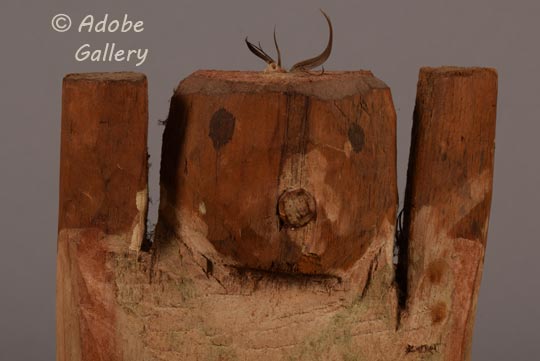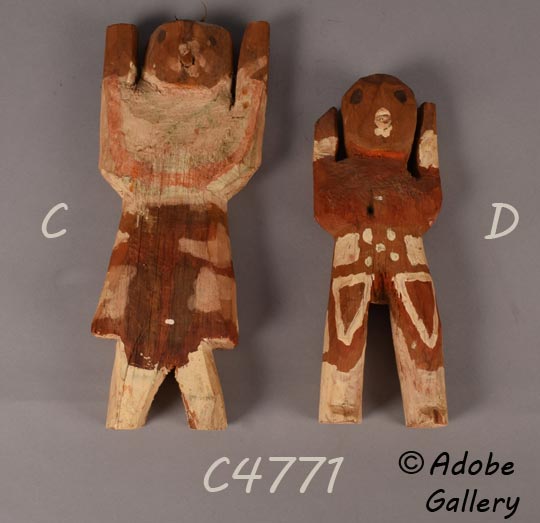Willeto Carved Figure with Raised Hands [SOLD]
+ Add to my watchlist Forward to Friend
- Category: Other Items
- Origin: Diné of the Navajo Nation
- Medium: wood, paint, metal wire
- Size: 12” height
- Item # C4771C SOLD
This wood carving was created by Charlie Willeto, a notable Diné folk artist. Willeto created his artworks using just wood and whatever materials he could obtain for coloration, including various paints and dyes. Here, we have a figure with raised arms, which is a common Willeto motif that somehow feels fresh with each example.
This carving was enhanced with painted designs in red, green, and white. They have faded and blurred together a bit over the years, which Willeto collectors will know is not unusual. A faint trace of a squash blossom necklace appears over a white shirt. Down below, amorphous blocks of white and green appear over red. The figure is modestly sized but carries a powerful presence.
We believe that this could be early-career work. A number of similar examples appear in the book "Collective Willeto: The Visionary Carvings of a Navajo Artist," which was published in 2002 by the Museum of New Mexico Press.
Charlie Willeto (1897-1964) was a Diné artist who was unrecognized during his lifetime but has, in recent years, received a great deal of acclaim for his folk-art carvings. Willeto's father, Pablo Walito, was a Diné medicine man; his mother Adzaan Tsosie "Slender Woman" was a medicine woman. Willeto himself followed into his parents' profession and married a woman who was born into the traditional Diné healing arts. At the time of Charlie and Elizabeth's arranged marriage, he was almost fifty and she was 18. They would go on to have six children together, many of whom would become artists themselves. Willeto was a Yei-bi-chei dancer, and his earliest known carvings were what he referred to as "replicas" of the Yei-bi-cheis. His elders discouraged him from continuing to make his "replicas'', and he moved in a different but similarly controversial direction.
In 1961, Willeto began creating the carvings for which he is celebrated today. These works—his early pieces, in particular—bore a resemblance to the "illness" or "healing" dolls made for use in Diné ceremonial functions. They always featured some sort of deliberate aberration, though, as the re-creation of these dolls was frowned upon by the Diné. Humans, anthropomorphic figures, and all manners of animals were Willeto's preferred subjects. He painted his carvings with house paint, chalk, crayons, and his wife's weaving dyes. The carvings ranged in size from a few inches tall to nearly life-size, with the majority standing between one and three feet. Willeto bartered his carvings for provisions, with trader Jim Mauzy. Mauzy then sold and traded Willeto's carvings to other dealers and collectors. Willeto is believed to have completed about 400 carvings in total. Today, his works are included in many prominent public and private collections, including the Smithsonian and the Museum of International Folk Art.
Condition: excellent condition
Provenance: this Willeto Carved Figure with Raised Hands is from a private collection of a resident of New Mexico
Reference: Collective Willeto: The Visionary Carvings of a Navajo Artist, Museum of New Mexico Press
TAGS: Diné of the Navajo Nation, Charlie Willeto


- Category: Other Items
- Origin: Diné of the Navajo Nation
- Medium: wood, paint, metal wire
- Size: 12” height
- Item # C4771C SOLD



